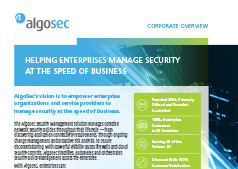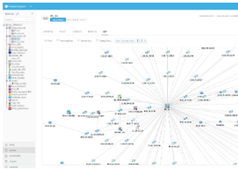5 Things You Didn't Know You Could do with a Security Policy Management Solution




Today’s enterprises are continuously evolving to support new applications, business transformation initiatives such as cloud and SDN, as well as fend off new and more sophisticated cyber-attacks on a daily basis. But security and network staff are struggling to keep up – which not only impacts business agility but exposes your enterprise to risk and hampers its ability to address the modern threat landscape.
Many professionals believe that they need the latest and greatest new tools to address these challenges. But what if you already have what you need, up and running in your organization: your security policy management solution?
Today’s security policy management solutions do far more than automate traditional change management tasks. In this technical webinar, Edy Almer, VP of Products at AlgoSec highlights 5 key security management challenges facing enterprise organizations today and explains how AlgoSec’s solution can help you manage security, reduce risk and respond to incidents while maximizing business agility and ensuring compliance across your disparate, ever-changing, hybrid networks.
This technical webinar focuses on:

AlgoSec Corporate Overview
An overview of AlgoSec's vision, solution, customers, partners, corporate values and achievements.

AlgoSec Firewall Analyzer- See the whole picture
Discover, identify, and map business applications and security policies – anywhere. With the industry’s app-centric perspective, you can now gain clear visibility into the security policies and the business applications that run your business — across your hybrid network. AlgoSec Firewall Analyzer enables you to stay on top of your security posture with continuous analysis and detection of risk and compliance gaps, allowing you to adapt quickly before an attack happens.

Examining the Security Policy Management Maturity Model
Does the following scenario sound familiar? Your network complexity is getting out of hand with too many firewalls, routers, switches, secure web gateways and more, as well as the related security policies. New network security devices with more granular and different types of controls have recently been or are being deployed in the network. At the same time the business is putting more demands on you to manage "ASAP" with requirements changing regularly. You don't have proper visibility of the security policies, compliance audits are a major burden, you can't keep up with all of the changes and you can't possibly know the impact of a security change or risk to a application that is critical to the business. If any or all of the above sounds familiar, you're not alone. Many enterprise networks are too complex, with numerous security devices and thousands of policies that must be managed across multiple vendors, different stakeholders and geographical locations. As new security technologies from different vendors are introduced into production environments, organizations not only have a maturity level in terms of what devices and capabilities are deployed, but also with regards to how the security policy is managed. From our work with more than 1000 enterprises from around the globe, we have been able to gain valuable insights used to craft the security policy management maturity model. This maturity model can help organizations recognize their current environment and to provide a roadmap for simplifying security policy management and gaining the crucial business perspective that is often lacking. I'm pleased to be joined on a webcast tomorrow with Eric Ogren of The Ogren Group, where we'll examine the security policy management maturity model and: Explore the challenges involved with managing the security policy such as understanding network topology and traffic flows, application connectivity requirements, risks in the policy, the purpose of each rule in the estate, and much more; Drill down into the benefits that can be achieved at each level; Offer recommendations for moving to a more automated and application-centric approach that involves security administrators, network operations, compliance officers, application owners and senior management. I hope to see you on the webcast tomorrow and get your feedback on the maturity model.

The network security policy management lifecycle
How a lifecycle approach improves business agility, reduces risks, and lowers costs